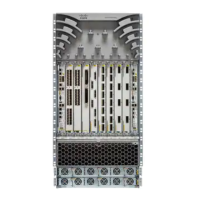SUMMARY STEPS
1.
admin
2.
show logging onboard [all | cbc {dump-all | dump-range {start-address | end-address | most-recent
{fans fan-tray-slot | [location node-id]} | diagnostic | environment | error | temperature | uptime |
verbose | voltage] [continuous | historical | static-data] [detail | raw | summary] [location node-id]
3.
show processes include obfl
4.
show running-config
DETAILED STEPS
PurposeCommand or Action
Enters administration EXEC mode.admin
Example:
RP/0/RSP0/CPU0:router# admin
Step 1
Displays stored OBFL data for all nodes or for a
specified node.
show logging onboard [all | cbc {dump-all | dump-range
{start-address | end-address | most-recent {fans fan-tray-slot |
Step 2
[location node-id]} | diagnostic | environment | error |
See the Onboard Failure Logging Commands
module in the Cisco ASR 9000 Series Aggregation
temperature | uptime | verbose | voltage] [continuous |
historical | static-data] [detail | raw | summary] [location
node-id]
Services Router System Monitoring Command
Reference.
Example:
RP/0/RSP0/CPU0:router(admin)# show logging onboard
uptime
Confirms that the OBFL environmental monitor
process is operating.
show processes include obfl
Example:
RP/0/RSP0/CPU0:router# show processes include obfl
Step 3
Displays the status of OBFL configuration.show running-config
Example:
RP/0/RSP0/CPU0:router# show running-config
Step 4
Clearing OBFL Data
To erase all OBFL data on a specific card or on all cards, use the following command:
clear logging onboard [all | cbc {dump-all | dump-range {start-address | end-address | most-recent {fans
fan-tray-slot | [location node-id]} | corrupted-files | diagnostic | environment | error | poweron-time |
temperature | uptime | voltage] [location node-id]
Cisco ASR 9000 Series Aggregation Services Router System Monitoring Configuration Guide, Release 4.2.x
317
Onboard Failure Logging
Clearing OBFL Data

